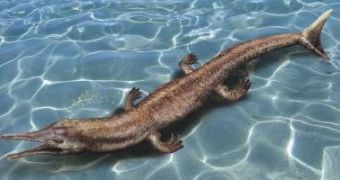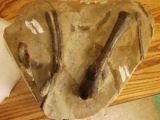Crocodiles are as old as dinosaurs.
Now, researchers made an astonishing discovery from the period when crocodiles' prey was formed by dinosaurs.
The fossil compasses about 50 % of a 1.8-2.4 m (6- 8-ft) crocodile, including long, needlepoint teeth found imbedded in Jurassic rock on private property in the Snowshoe Formation of the Izee Terrane south of Dayville, Oregon.
"Rocks containing the fossils were slowly cut out of the rock, after North American Research Group (NARG) members realized that the linear appearance of the fossils in the region's hard rocks suggested that a whole creature had been found, This taxon was a crocodile-like creature but had a fish tail," said William Orr, a NARG adviser and director of the Thomas Condon State Museum of Fossils at the University of Oregon.
"This creature lived in Jurassic times, so it's 150 to 180 million years old. It probably lived in a tropical estuarine environment. The remains of the crocodile, believed to be from the species Thalattosuchia and member of the Metriorhynchids group, now belong to the state," Orr said.
NARG members are private researchers with experience and interests in paleontology, paleonbotany and geology who study the Pacific Northwest. The fossil was first time located by Andrew Bland, a NARG member, in October 2005. "I followed the bone fragments I was finding up hill a few feet to the area they were weathering out of. I started to dig and found more bone material."
Thalattosuchia was common around much of the world during the Jurassic Period (middle dinosaur era). Based on fossils' locations, Thalattosuchians may have been semi-aquatic freshwater reptiles that evolved into fully marine crocodiles. "Fossils similar to the Oregon crocodile appear today in many areas around South China," said Orr.
The short stubby legs of these crocodiles would have permitted them to move about land, where they laid eggs while webbed feet and the fish-like tail would have made them agile swimmers, making them effective aquatic predators. "Fossils from other crocodile families and other reptiles, especially ichthyosaurs, from the Mesozoic Era (the dinosaur era) have been found previously in Oregon, but none have been as old as the newly found crocodile," Orr said. "While fossil marine crocodiles frequently occur in Jurassic rocks of Europe and Africa, they are scarce in North America," noted Orr.
Probably in those times, the northern continent formed just one landmass, from China to Europe and North America. Oregon is poor in dinosaur bone: just a single dinosaur bone fragment, from the Cretaceous Period (65 million to 144 million years ago), has been found here so far. "The new discovery suggests that dinosaur fossils must be out there somewhere, but we just haven't looked hard enough", said Orr.

 14 DAY TRIAL //
14 DAY TRIAL // 
